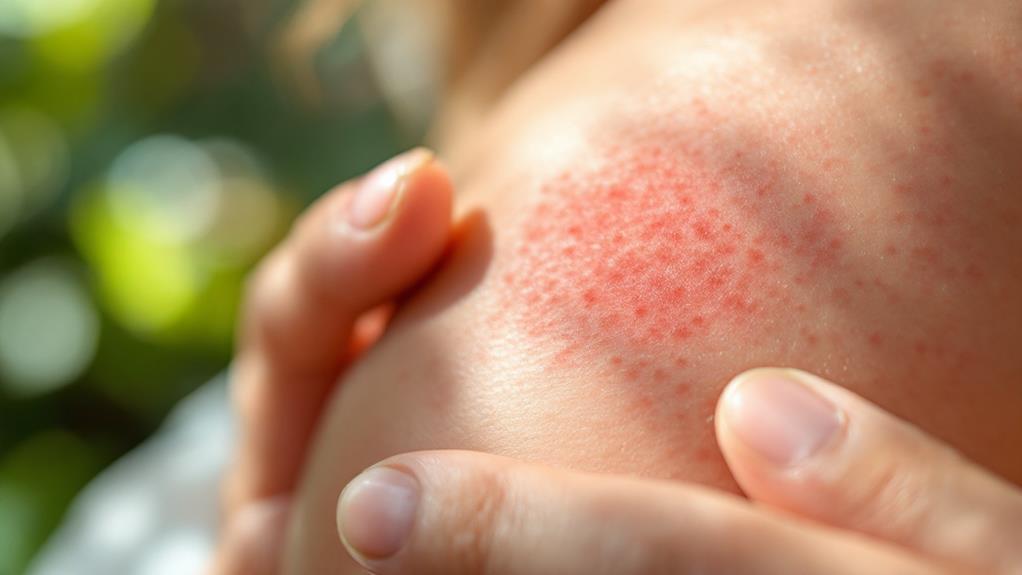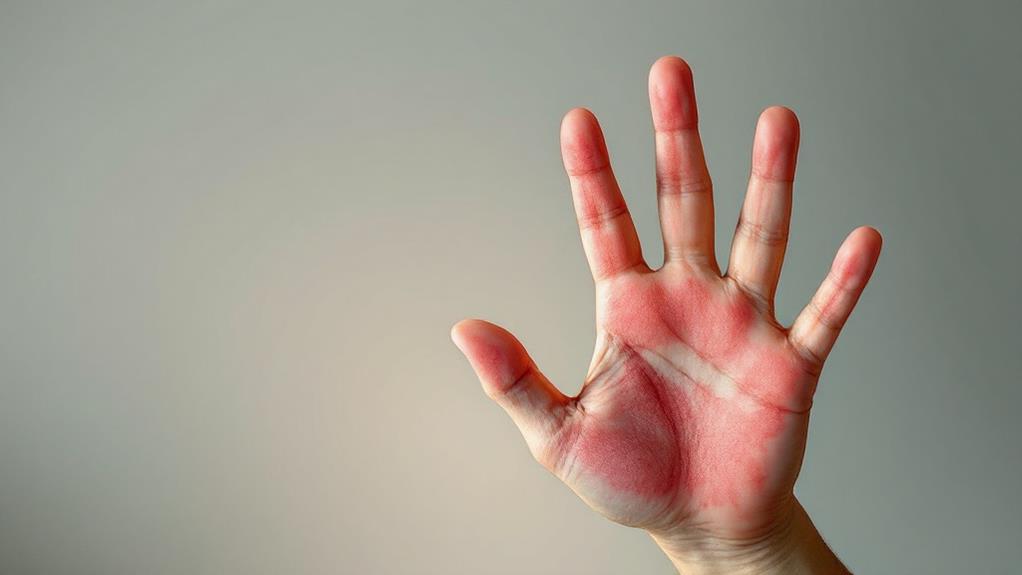The Strangest Allergies in the World: Unusual Reactions Explained

You're about to investigate some of the strangest allergies in the world that challenge conventional understanding. Imagine being allergic to water, where even a shower can cause hives. Cold weather might seem harmless, but for some, it triggers severe reactions like anaphylaxis. You might not believe it, but even sunlight and vibrations can cause surprising allergic responses. Then there's exercise-induced anaphylaxis and unexpected allergies to human touch that redefine personal interactions. These conditions require careful management strategies. And yes, there are even bizarre food sensitivities and metal allergies that make everyday situations tricky. Brace yourself to investigate these fascinating facts!
Water-Induced Urticaria
Though it might sound impossible, water-induced urticaria is a real and rare condition where exposure to water causes hives or a rash on the skin. If you've never heard of it, you might wonder how something as vital as water could trigger an allergic reaction. The truth is, this condition can make simple activities like showering or swimming a formidable challenge.
When you have water-induced urticaria, you might notice water allergy symptoms like itching, redness, and raised welts appearing shortly after contact with water. These symptoms typically fade within 30 to 60 minutes but can be uncomfortable and distressing. The severity varies among individuals, with some experiencing mild irritation while others face more intense reactions.
If you're dealing with this unusual allergy, exploring treatment options is important. Antihistamines are often recommended to manage symptoms, though they might not be completely effective for everyone. In some cases, doctors might suggest ultraviolet light therapy or even prescribe medications that stabilize the skin's reaction. It's crucial to work closely with an allergist or dermatologist to tailor a treatment plan that suits your specific needs, helping you manage your symptoms and maintain a better quality of life.
Cold Weather Reactions
Water isn't the only element that can trigger unexpected allergic reactions. If you've ever noticed itchy welts on your skin after exposure to the cold, you might be experiencing cold urticaria. This condition causes your skin to react with hives when it's exposed to chilly temperatures. It's more than just discomfort; in severe cases, it can lead to anaphylaxis, a life-threatening reaction. Imagine stepping out on a frosty morning, only to feel your skin erupt in itchy, red patches. It's not just the cold air that can trigger this reaction—bathing in cold water or even holding a chilled drink might set it off.
Cold urticaria isn't the only concern. Some people experience what's termed frostbite allergies. Unlike typical frostbite, where skin freezes due to extreme cold, these allergies result in symptoms similar to those of an allergic reaction. Your body might misinterpret the cold as an invader, leading to swelling, redness, or even numbness. It's essential to recognize these reactions early and take preventive measures, like dressing warmly and avoiding sudden temperature changes. Cold weather reactions might seem strange, but understanding them can help you manage your health better.
Sunlight Sensitivity

How do you react when the sun touches your skin? For most, sun exposure is a welcome warmth, but for some, it triggers an unusual sensitivity. This condition, often referred to as photosensitivity, is an abnormal reaction to UV radiation. Imagine stepping outside on a bright day, only to find your skin breaking out in rashes, red patches, or even painful blisters. It's not just a sunburn; it's your body fighting against the sun's rays.
You might experience symptoms within minutes of exposure, making it challenging to enjoy a sunny day. This sensitivity can result from multiple factors, including certain medications, autoimmune disorders, or genetic conditions like xeroderma pigmentosum. The sun's UV radiation can damage skin cells, and for those with sunlight sensitivity, the body's defense mechanisms overreact, causing discomfort and visible skin issues.
Managing sunlight sensitivity involves more than just slathering on sunscreen. You'll often need to limit your time outdoors, wear protective clothing, and perhaps seek shade whenever possible. It's about balancing the need for sun protection while trying to maintain a normal lifestyle. Understanding this sensitivity can help you navigate sunny days with more confidence and care.
Vibrations and Hives
While the sun's rays can be a formidable adversary for some, others find their skin reacting to something seemingly innocuous—vibrations. This unusual condition, known as vibration sensitivity, triggers an allergic-like response in certain individuals. Imagine simply riding in a car, using a lawnmower, or even clapping your hands, and suddenly finding your skin erupting in hives. It's not just the vibrations themselves but how your body perceives and reacts to them.
When you experience vibration sensitivity, your body misinterprets these harmless vibrations as a threat. This results in the release of histamines, which are chemicals your immune system produces to fight off perceived dangers. Unfortunately, in this case, they lead to hives, a common reaction that includes red, itchy welts on your skin.
Hives triggers vary from person to person, but common culprits include everyday activities or tools that cause repeated motion. If you suspect you're dealing with this peculiar sensitivity, it's wise to consult a healthcare professional. They can help you identify specific triggers and develop a management plan, ensuring you're equipped to handle situations where vibrations might otherwise cause discomfort.
Allergic to Exercise

Imagine feeling an overwhelming sense of dread at the mere thought of physical activity. For some, this fear isn't just mental; it's a very real, physical reaction known as exercise induced anaphylaxis. If you suffer from this rare condition, your body responds to exercise as if it's a threat. Instead of the typical benefits of a workout, you're met with hives, difficulty breathing, and even a drop in blood pressure.
Physical activity intolerance might sound like an excuse to avoid the gym, but it's a serious condition that can disrupt daily life. You might experience symptoms only during certain activities or when combined with specific foods or medications. For instance, eating particular foods before exercising can trigger severe reactions, turning what should be a healthy routine into a dangerous ordeal.
Managing this condition involves more than just avoiding exercise. It's vital to identify triggers with the help of an allergist. Carrying an epinephrine auto-injector becomes fundamental for safety. Though it sounds intimidating, understanding your body's limits and working with medical professionals can enable you to safely engage in physical activity, even if it's in a modified form.
Metal Allergy Mysteries
Metal allergies might sound unusual, but they're more common than you'd think. Many people suffer from metal sensitivity, especially in relation to nickel, a metal found in everyday items like jewelry, belt buckles, and even phones. When your skin comes into contact with these objects, you might notice an itchy rash, known as nickel dermatitis. But why does this happen?
- Genetic Predisposition: Some individuals are genetically predisposed to develop metal allergies. If your family members have experienced similar issues, you might be more likely to experience metal sensitivity yourself.
- Prolonged Exposure: The more frequently and longer your skin is exposed to nickel, the greater the chance of developing a sensitivity. Even a favorite piece of jewelry could eventually trigger a reaction.
- Environmental Factors: Certain environmental conditions, like high humidity or sweating, can exacerbate nickel dermatitis, making symptoms more severe and uncomfortable.
- Cross-Reactivity: If you're allergic to other metals, such as cobalt or chromium, you might also react to nickel due to cross-reactivity. This means your immune system mistakes one allergen for another, triggering a response.
Understanding these factors can help manage and avoid metal allergies effectively.
Pressure-Induced Rashes

Pressure-induced rashes might sound perplexing, but they're a reality for many. Imagine you're carrying a heavy bag on your shoulder or leaning against a hard surface. Suddenly, your skin reacts with redness, swelling, or even welts. These pressure triggers cause your body to respond unusually, leading to visible dermal responses. It's not just discomfort—it's an allergic reaction to pressure that can be both surprising and hard to manage.
This condition, known as dermatographia or dermographism, happens when your skin cells release histamines in reaction to pressure. Unlike typical allergies, where substances like pollen or food cause reactions, here, it's the physical force that acts as the catalyst. You might notice these rashes appearing shortly after the pressure is applied, and they can last from minutes to hours.
Preventing pressure-induced rashes involves avoiding prolonged pressure on sensitive areas. Wearing loose clothing and using padding in areas prone to pressure can help. If you experience these reactions frequently, it might be worth consulting a healthcare professional. They can provide guidance on managing these dermal responses, ensuring you're comfortable and rash-free in your daily life.
Color Dye Sensitivities
Encountering unexpected reactions from everyday items, you might be surprised to learn that color dye sensitivities can impact your life in significant ways. These sensitivities often stem from different color dye sources, which can be found in clothing, cosmetics, and even food. When you're sensitive to these dyes, you might experience dye allergy symptoms such as itching, redness, or swelling. Steering through a world filled with lively colors means understanding the potential triggers.
Here's what you need to know:
- Fabric Dye Reactions: Clothes and textiles are common culprits. Washing new clothes before wearing them can help minimize irritation from residual dyes.
- Synthetic Dye Risks: Synthetic dyes, often used for their lively hues and cost-effectiveness, might increase the risk of allergic reactions. Reading labels carefully can help you avoid these dyes.
- Natural Dye Allergies: Even natural dyes, often considered safer, can cause reactions. It's important to know your specific allergens, as natural doesn't always mean harmless.
- Color Dye Sources in Products: From hair dyes to makeup, many products contain dyes. Opt for hypoallergenic or dye-free options if you're experiencing reactions.
Allergies to Human Touch

While color dye sensitivities can be surprising, perhaps even more perplexing are allergies to human touch. Imagine you're meeting a friend and upon shaking hands, your skin erupts in a rash or hives. This condition, known as touch induced dermatitis, affects some people in ways that make everyday interactions uncomfortable. A mere handshake is not the only thing that can trigger a reaction—any physical contact, even a gentle pat on the back, might cause your skin to flare up.
You might find intimacy reactions particularly challenging. When you're close to someone, physical touch is often a natural expression of affection. However, for those with this unusual allergy, such moments can lead to discomfort or even pain. This doesn't just affect romantic relationships—it can also impact familial bonds and friendships, as avoiding touch becomes a priority to prevent reactions.
To manage this condition, it's crucial to identify and avoid triggers. Some people might need to use barrier creams or medications to reduce sensitivity. While it's a rare condition, understanding and empathy from those around you can make a significant difference in maneuvering a world where touch is often unavoidable.
Uncommon Food Reactions
Uncommon food reactions can be baffling, especially when common ingredients trigger unexpected responses. Imagine enjoying a seemingly harmless meal only to experience symptoms from mystery food allergies. These reactions are not only puzzling but sometimes even life-changing. Understanding them involves digging deeper into how unusual ingredient reactions manifest, and identifying rare spice sensitivities or cross reactive foods that might be responsible.
Here are some examples to illustrate these perplexing reactions:
- Rare Spice Sensitivities: You might find that a dash of a particular spice, like asafoetida or fenugreek, leads to an allergic reaction, leaving you puzzled about the cause.
- Cross Reactive Foods: Certain proteins in one food may mimic those in another, causing your body to react. If you're allergic to birch pollen, you might react to apples or celery, seemingly unrelated foods.
- Mystery Food Allergies: Sometimes, the culprit isn't obvious, and it takes time and testing to pinpoint the allergen in your diet that's causing the discomfort.
- Unusual Ingredient Reactions: Even common foods like corn or tapioca can induce unexpected reactions, catching you off guard and requiring careful avoidance.
These examples highlight the importance of awareness and vigilance when dealing with food allergies.



